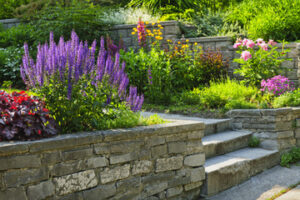Landscaping Fayetteville AR can help improve the health and appearance of a property, while also saving time and money in maintenance. Do-it-yourself landscaping can be as simple as adding a few deciduous trees to your landscape to provide fall color, or you might want an elaborate design that requires a professional.

Using the principles of harmony, unity, transition, and focalization will add beauty to your landscape.
Color is one of the most important design elements in a landscape. It creates a mood, unifies a design, and draws attention to focal points. Incorporating color into your landscaping is easy with the help of a few key principles.
The color wheel is the perfect tool to use when thinking about your landscaping colors. It shows the relationships between warm and cool hues as well as how they complement each other. Complementary colors are opposite each other on the wheel and they enhance one another by making them stand out more. For example, yellow and purple are complementary colors because they make each other appear brighter.
In order to achieve a sense of unity, you can use similar colors in your landscaping. This can be achieved by using plants with the same foliage color, flowers of the same color, or a planting scheme that uses different shades of the same color. For instance, using plants with the same green color in your landscape will give it a unified look, while choosing plant colors that are all on the same side of the spectrum (warm vs. cool) will add a cohesive feel.
Contrasting colors can also be used to create depth and separate different aspects of your yard. For instance, contrasting the size of flower petals, shrubbery, or the texture of a leaf will draw the eye. Similarly, a contrast in the texture of hardscaping, like paving or walls, can add interest to your landscape.
Another way to achieve a sense of unity is to choose a theme for your landscaping. This could be based on color, such as warm or cool tones, or it can be a style or theme that you like, such as a Zen garden for relaxation, a Mediterranean garden for excitement, or an English garden for elegance.
The best way to get ideas about how to incorporate color into your landscape is to observe other people’s gardens and yards in your area. Take note of the colors that attract you and ask yourself why they are appealing. This will give you a good idea of the basics of what you want your own landscape to look like.
Form
While color may be the most recognizable element of landscape design, form and texture are equally important to consider. These features help create harmony and balance in your landscaping composition and can contribute to the overall feel of a space. The shape of flowerbeds, ponds and other hardscape elements can influence the movement of the eye throughout your outdoor area, while the shapes of plants, hedges and trees can add texture and visual interest to the composition.
Line refers to the movement of the eye through the landscape and is often one of the most overlooked aspects of a landscape. It plays a vital role in the way your landscape flows, from paths and walkways to the flow of your garden beds and paving materials. Lines can also be used to highlight a specific design feature like a water feature or fire pit. They can be straight or curved, horizontal or diagonal and can add an exciting or calming feel to your landscape.
Form focuses on the three-dimensional qualities of your landscape, contrasting with lines which are two-dimensional. Plants, pathways, driveways and other natural and hardscape elements have unique forms that are both structural and aesthetically pleasing. Straight or axial lines can give a formal appearance while curved lines create a more relaxed character, especially when incorporated into the edging of your garden beds and paved areas.
Texture describes how rough or smooth, coarse or fine, light or heavy a plant or hardscape element feels. It is a crucial component of any landscaping design and is often overlooked as it is not immediately noticeable. A contrasting mix of textures is essential to creating contrast and balance in your garden, as repetition of the same texture can create monotony.
Like color, form can be a permanent aspect of your landscape design or it can be changed with the seasons or the movement of the sun across your property. The brighter, more intense summer sun can make colors appear saturated and vibrant, while filtered sunlight in the winter can cause them to be subdued. In order to maintain the desired color throughout the seasons, you will need to plan ahead and incorporate foliage that will offer a seasonal selection of hues.
Movement
A well-designed landscape has movement that creates a unified and harmonious whole. This is achieved through the use of varying heights, shapes and colors of plants, transitions and other design elements. Movement also involves the use of focalization, which draws the eye to a specific element within the landscape. Focalization can be accomplished by using objects like statues, water features, gazebos and flower gardens.
In addition to designing the overall layout of a garden, landscaping professionals oversee the installation and construction of various landscaping elements. This includes the planting of trees, shrubs, flowers and turfgrass; as well as the building of hardscape features such as pathways, patios, decks, retaining walls and fences. Landscapers ensure that installations are completed correctly and according to local building codes and regulations.
Landscaping has many benefits for homeowners and businesses alike. Studies have shown that people feel happier and healthier when surrounded by greenery. Moreover, landscaping increases property value and provides environmental and economic benefits. Landscaping is an important part of urban planning, and it helps to maintain the balance between nature and man-made structures.
Theme and hierarchy are two important concepts when designing a landscape. Theme refers to the overall look of a landscape, and it can be anything from a formal architectural style to a more natural setting such as a desert or meadow. Hierarchy, on the other hand, is a system of visual cues used to create a sense of order and organization in a space.
Lines are another important aspect of landscaping. They help to guide the viewer’s eyes throughout the space and create a flow between different areas of the garden. The lines can be either perceived or physical, and they can be curved, straight, horizontal, diagonal or radial. The most effective landscapes use a combination of these lines to create movement and add depth and dimension.
When choosing a landscape theme, it is important to consider the purpose of the space. For example, if the space is intended for entertaining, a more formal setting may be appropriate. However, if the space is meant for relaxation, a more informal design may be more suitable. It is also important to choose a theme that will complement the architecture of the home or business.
Focalization
Focalization is one of the most important aspects of landscape design. The idea is to create a center of interest within the garden or yard that draws attention and draws your eye from every direction. A focal point can be anything from a large tree to a dramatic water feature or even an artistic sculpture. The key is to balance it with the surrounding landscape, ensuring that it isn’t overpowering or that it doesn’t become lost in the overall design.
While the concept of focalization may seem simple, it is actually quite complex. For example, a focal point should have a variety of shapes and colors to make it stand out from the surrounding plants and flowers. It also needs to have a variety of textures and movement in order to capture your attention. Then there are the proportions that are used to balance the focal point with the rest of the landscape. This includes both symmetrical and asymmetrical balance as well as the use of relative proportions and scale.
Focal points often occur naturally in a landscape. For instance, a stunning view of the mountains may serve as the primary focal point of a garden that is designed around it. Skilled landscapers can also identify these natural features and then work to highlight them by using a variety of colors, textures, and other elements to draw the eye.
A well-designed landscape should include a variety of elements that offer visual and functional balance. A balanced landscape offers a pleasant and comfortable experience for the viewer. This is accomplished through a combination of the six design principles: proportion, movement, color, texture, harmony and focus.
By incorporating these landscape design principles, you can create a stunning outdoor space that is sure to impress your guests and friends. For more information on how to incorporate these landscaping concepts into your property, contact the experienced professionals. We can help you identify the best focal points to enhance your home and create a space that is both beautiful and calming.

